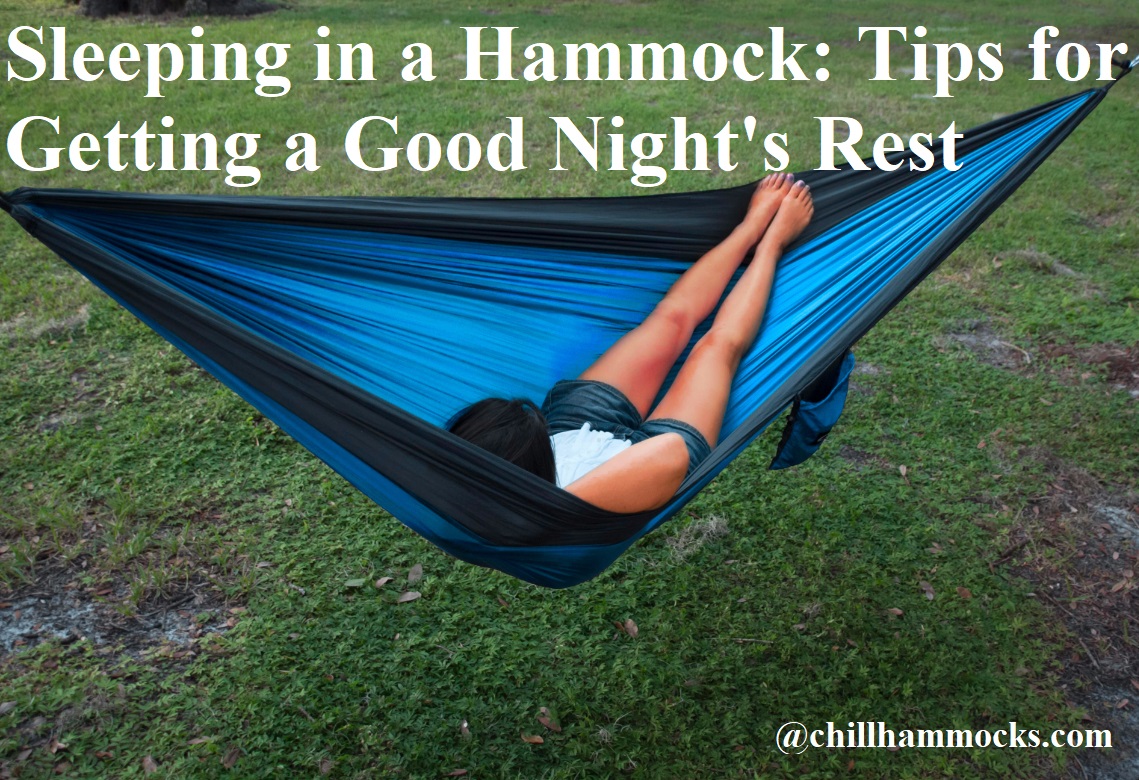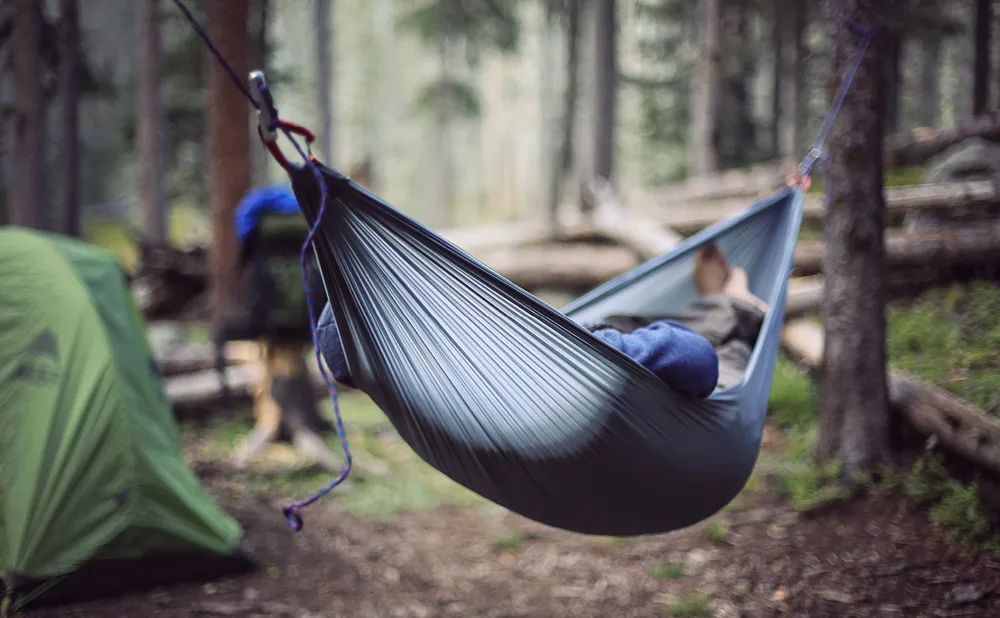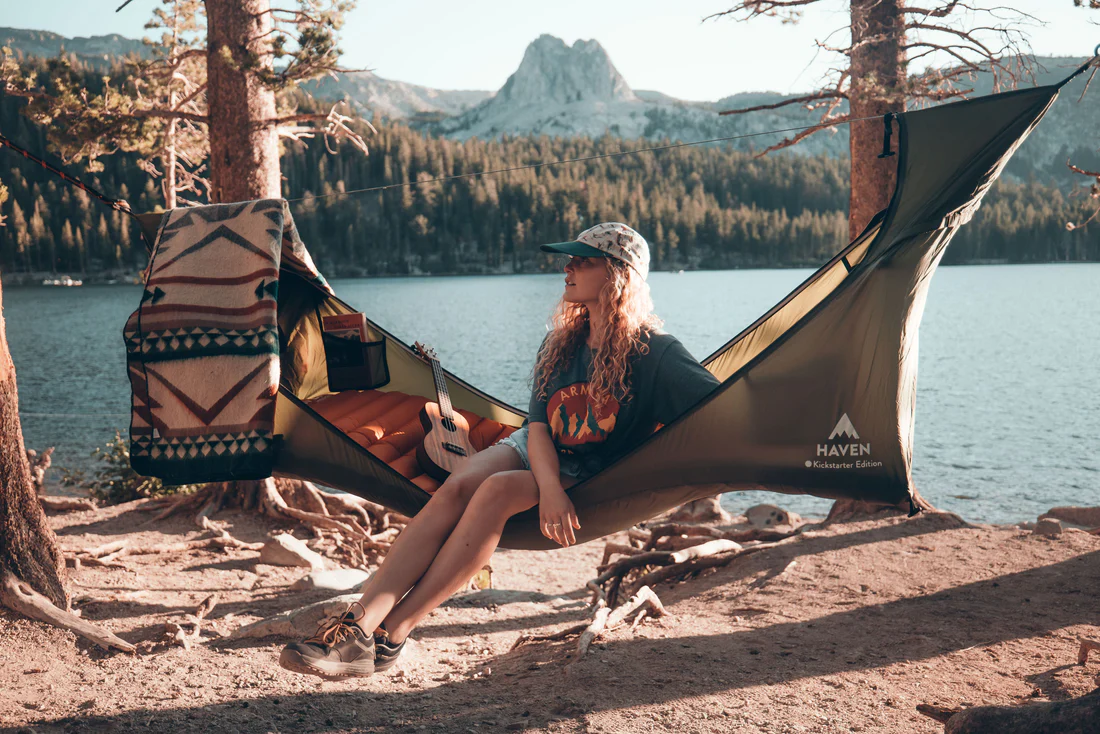Are you longing for a more comfortable night’s sleep? If you’re looking for a unique way to enjoy your rest, try sleeping in a hammock!
In this guide, you’ll discover how to get the most out of your hammock with tips and tricks that will revolutionize your sleep.
Hammocks are becoming increasingly popular all over the world, and it’s easy to see why. Whether you’re camping, backpacking, or just lounging in your own backyard, a hammock offers a comfortable spot to relax and soak up some sun. But did you know that you can also get a good night’s sleep in a hammock? Yes, it is possible to get quality rest while sleeping in a hammock!
In this guide we will be discussing what makes sleeping in a hammock so different from sleeping on the ground or in bed, how to create the ideal environment for sleeping in a hammock, what kind of hammocks work best for sleeping, and how to ensure it provides both comfort and security. Once you’ve read through this guide and become more familiar with the art of “hammocking” , you’ll be well on your way toward getting the sleep that everyone needs.
Explanation of why sleeping in a hammock is becoming more popular
In recent years, sleeping in a hammock has gained in popularity, especially amongst outdoor enthusiasts and campers. This is largely due to the convenience and portability of the hammock, as well as the comfort factor. With the right set up and accessories, sleeping in a hammock can provide a good night’s rest even when camping or exploring remote areas.
Hammocking also offers some distinct advantages over sleeping on the ground. For starters, it is impossible to directly transfer your body heat to the ground while in a hammock, making it a much better option in colder climates. Also, since you are suspended from the trees or posts above, there is no need for additional insulation on the ground underneath you like with traditional camping tents and pads. This makes for an easier set up and packing process where space may be limited.
From its portability to its convenience and comfort factor, there are many reasons why sleeping in a hammock has become so popular among explorers of all sorts. With careful planning and thoughtful consideration of factors such as weight of materials and sleeping temperature ranges for extreme weather conditions, sleeping in a hammock can give you both comfort and reliability during trips out into nature’s wild domain.
Overview of the benefits of sleeping in a hammock
Sleeping in a hammock can offer numerous benefits to those who choose this alternative way of sleeping. Most people tend to think that sleeping suspended in the air is uncomfortable, but the truth is that hammocks offer extra support and stability, as well as excellent ventilation, making it one of the most comfortable places to sleep. Additionally, sleeping in a hammock offers a great feeling of security while also providing numerous physical and mental health benefits such as:
- Improved posture: Hammocks are designed to naturally align with your body which can result in improved spinal alignment and reduce pressure on joints.
- Alleviate muscle tension: Hammocks give you freedom of movement and help stretch out your muscles for a better sense of relaxation and better night’s sleep.
- Increased circulation: As hammocks allow for uniform distribution of weight throughout the body, they help increase blood circulation leading to improved oxygen delivery through your body.
- Reduce stress levels: The swaying motion found when sleeping in a hammock has been proven to reduce stress levels by releasing endorphins or “happiness hormones” resulting in increased feelings on tranquility and well-being.
- Promote deeper sleep: Studies have shown that the rocking motion found when sleeping in a hammock helps induce both speedier entry into deep sleep as well as an increase its duration overall which can help ensure more restful nights due to deeper REM cycles.
Choosing the Right Hammock
For a good night’s rest in a hammock, it is important to choose the one that is most suited to your needs. Hammocks come in different styles and are made from different materials. Below is a guide about selecting the best hammock for you and your lifestyle.
Style: There are several types of hammocks available, ranging from the classic rope or string style to specialized “travel” or “mountaineering” designs. Traditional rope and string-style hammocks can be more comfortable, but they may not be ideal for those who travel frequently or need more substantial back support. Travel-style hammocks are typically constructed of lightweight synthetic materials like nylon or polyester that offer better support and easier setup than traditional models – meaning you won’t waste time fumbling with knots every night you sleep in your hammock!
Material: The type of material used in a hammock will affect its longevity as well as its comfort level. Cotton can be comfortable but tends to stretch over time and isn’t as durable. Synthetic materials like nylon or polyester tend to last longer and provide greater comfort when sleeping in them – although some may find them less cosy than a pure cotton variety! Specialty synthetic “weather resisting” materials are also available for individuals who will be sleeping outdoors, where rain protection or extra UV protection may be necessary for long-term use of the device.
Size: It is also crucial to consider the size of your chosen model when purchasing a hammock – smaller versions provide greater portability but significantly less space while larger ones may feel more restrictive outdoors due to their bulkiness! A typical double size measures around 7ft (2m) wide with room enough for two adults (or one large adult). However, if you plan on inviting friends over often, there are special models called “family sized” which measure up to 11ft (3m) wide and can accommodate multiple people at once.
Size considerations
The most important factor to consider when shopping for a hammock is the size. A good-size hammock will provide more space so that you can stretch out comfortably and easily turn around while you sleep.
Standard size options might range from a single-person option, ranging from 8.5 feet up to 13 feet, to oversized double options ranging from 10.5 feet up to 17 feet long. Choose one that matches your own height and sleeping style best.
Shorter lengths are recommended for those who prefer sleeping diagonally or plan on doing some recreational activities such as camping in their hammock. Longer models are ideal for those who plan on using their hammock solely for sleeping.
Material options
When shopping for a hammock, you’ll need to choose natural or synthetic materials. Natural options include cotton, parachute nylon, and organic fan-tail. Cotton is a classic choice that breathes well in hot weather and is found in most traditional hammock styles. Parachute nylon is ideal for heavier hammocks and offers the best support for people of larger stature. Organic fan-tail is the newest material on the market, offering breathability and comfort with an elegant draping effect.
Synthetic options are becoming more popular for use in all climates due to their ability to resist wind and rain, offer convenience when traveling, withstand colder temperatures and look attractive when set up. People also like them because they can often be purchased at a lower price than natural materials. Typical synthetics are lightweight ripstop nylon with netting in bright patterns or solid colors that complement any outdoor living landscape.
No matter how much time you intend on spending outdoors in your hammock, it’s important to choose one made of quality materials that will provide years of restful sleep or relaxing lounging time. It’s also important to note that material thickness affects overall weight capacity but doesn’t affect comfortability; thinner materials are typically just as comfortable as thicker fabrics — just make sure the extra lightweight option has been rigorously tested by the manufacturer before buying it!
Additional features to look for
While considering the size of the hammock and fabric you would like, there are some additional features that are important to think about that may improve your comfort and ensure a good night’s rest.
Insect protection is essential when camping, and if your hammock does not come with a built-in insect protection system, look for hammocks that have complete coverage from biting insects. The added layer of netting will give you peace of mind as you relax in your sleep cocoon.
Having a footrest can be beneficial for keeping your feet elevated off the ground and allowing for better circulation while sleeping or lounging in the hammock. This extra feature can make all the difference in both comfort and relaxation levels when spending time in a hammock.
One important factor to consider is the suspension system supplied with your desired hammock. Regular ropes or cords tend to stretch over time; therefore, it is best to invest in reliable suspension systems like rope slings or carabiners which are more durable, do not stretch, and offer superior tightness after each use.
Finally, look for accessories such as different length tree straps or rain tarps which could be purchased separately but provide extra sleeping benefits if desired when camping outdoors.
Setting Up Your Hammock
Once you have chosen the ideal spot for your hammock, it’s time to set it up. There are a few basics to consider when setting up your hammock:
- Choose the right suspension system: Hammocks and camp chairs typically require a different type of suspension system, but some hammocks come with their own carabiners or buckles. The type of suspension system also depends on whether you’ll be suspending your hammock between two trees or attaching it to a single post or wall.
- Set the tension properly: For optimal comfort and safety, make sure that all tension points have equal tension – over-tightening can lead to dangerous scenarios and under-tensioning can make for an uncomfortable sleep.
- Ensure proper support: Make sure that the supporting material is able to handle the full weight of an adult and that there is no heavy stress placed on any one point by ensuring even distribution of force throughout the entire suspension system. If using trees as anchors, check for signs of rot or disease before hanging up – don’t skip this step!
Choosing a location
When choosing the ideal spot to hang your hammock, keep in mind that you’ll want a level, elevated surface. The ground should be at least four or five feet above the ground and free of debris and rocks that could cause discomfort or disruption while sleeping. You should also make sure your hammock isn’t near trees or other obstacles that could side-swipe you while trying to get in or out of the hammock. If you are in a heavily wooded area, you may want to opt for a manufactured hammock stand specifically designed for hanging between trees.
Before settling on your final spot, check for any exposed branches overhead that might scratch you up if touched incorrectly. Also check for things such as sharp objects sticking out of tree trunks and low-hanging fork tails from nearby trees so you can avoid them entirely when using the hammock. Finally, ensure there’s sufficient space between two anchor points so that your body has enough room to lie down without being too squished (or worse, falling out!).
Hanging your hammock properly
Ensuring that your hammock is properly hung and tensioned is essential for getting a good night’s rest. The end ropes should be taut; if they are not, the hammock will sag, which can lead to an unpleasant night’s sleep. Use carabiners to join the rings on the ends of the ropes and adjust the height and tension by adjusting the length of each line individually.
For added anchoring, use extra tree straps on both sides to hold firmly in place so you stay securely suspended all night long. When positioning your hammock in a camping spot, try to hang it between two trees that are far apart enough for your body weight to be evenly distributed. This will help prevent too much pressure from being concentrated on one specific area and ensure optimal comfort throughout the night.
Conclusion
If you want to get a good night’s sleep using your hammock, there are several factors to consider. Relying on the tips and information provided here will help you choose the best synthetic or cotton fabric, select comfortable accessories, and practice perfect placement techniques.
Remember that your comfort and well-being is the first consideration in a safe and restful night in your hammock. Enjoy your cozy, calming sleep — you deserve it!
FAQ’s
Can you get a good night sleep in a hammock?
Yes, many people find hammocks comfortable and conducive to a good night’s sleep.
Is it OK to sleep in a hammock long term?
While some people do sleep in hammocks long term, it’s generally not recommended as it can lead to back problems and discomfort.
Why do hammocks make me sleepy?
Hammocks can promote relaxation and reduce stress, which can make you feel sleepy.
How do you comfortably sleep in a hammock?
To sleep comfortably in a hammock, lie diagonally with a slight curve in your body and use a pillow for neck support.
What is the danger of hammocks?
Improper installation or use of a hammock can result in falls, injuries, and even death.
Are hammocks healthier than beds?
There is no clear evidence that hammocks are healthier than beds, as individual preferences and needs vary.
What not to do with a hammock?
Do not overload or exceed the weight limit of the hammock, and do not hang it from weak or unstable structures.
Are hammocks good for mental health?
Hammocks can provide a sense of relaxation and reduce stress, which can contribute to improved mental health.
What is hammock therapy?
Hammock therapy involves using a hammock as a tool for relaxation and stress relief.
At what age is it safe to sleep in a hammock?
It is generally safe for children and adults to sleep in a hammock as long as it is properly installed and used. However, infants should not sleep in hammocks unsupervised.
See Also-
- Best heavy duty hammock with stand 2023
- Best portable hammock 2023
- Best hammock with mosquito net 2023
- Best indoor hammock 2023
- Best hammock under quilt 2023

